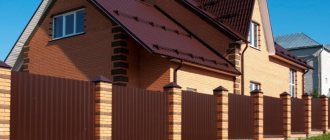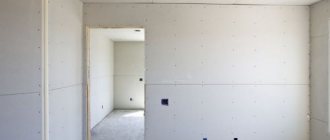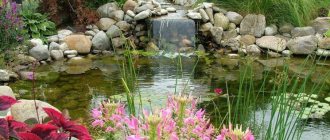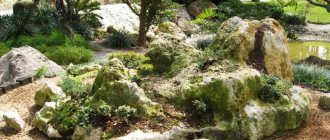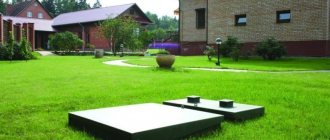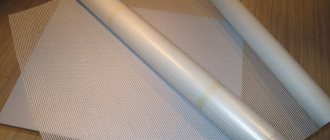Most summer residents and owners of private houses do not think about the aesthetic appearance of their beds, the main thing is that the harvest is good. However, if they have sides, they will look much neater. A neat and well-groomed garden will become the pride of the owner.
In addition to decorative purposes, borders will keep their shape, help save water and protect crops from weeds. Fencing can be purchased at a hardware store; the selection is simply huge. If the cost stops you, you can make them yourself.
How to properly arrange brick beds
Nowadays, the garden has ceased to be a purely utilitarian place that ensures the survival and food of the family. Increasingly, summer residents and gardeners are trying to find a compromise between practicality and aesthetics, striving to make their plots not only productive, but also comfortable and beautiful. One such landscaping technique is raised brick beds.
How to fasten craft parts
Garden craft parts cut from corrugated sheets are best fastened with rivets. A hole should be pre-drilled in the part using a drill. The fastener is inserted into it, the rod located inside is pulled up and secured, and its excess “tail” is bitten off. If connecting parts with rivets is difficult for you, fasten with wire, drilling the necessary holes.
Rivets - fasteners for corrugated sheets
This is what rivets look like on a corrugated sheet
This technology will make it possible to make amazing crafts for the garden that will delight everyone who sees them.
More interesting IDEAS FOR THE GARDEN
Common Benefits of Raised Beds
- The garden looks neat, well-groomed and stylish. The beds can be made of any shape and size. They will fit perfectly into any garden style. They can fill various corners of the site, forming functional zones: a vegetable garden, a tea bed, a herb garden, a strawberry garden, a flower garden. The border is clearly marked and the grass from the paths does not creep into the garden bed.
- Such ridges and paths between them are convenient to maintain. You don’t need to bend over too much, it’s convenient to use a folding chair, the rows can be filled with gravel or sawdust, seeded with lawn, paved with tiles or boards.
- This is an excellent solution for areas with soils unsuitable for farming, since the entire volume of plant soil is poured into a box. Poor soils include high groundwater levels, poor or rocky soils. In such cases, you will have to make a box 30-70 cm high so that the plant roots have enough bulk soil for growth and nutrition. It is also possible to arrange high beds on inconvenient slopes, increasing the usable area of the garden.
- In such beds, the soil warms up earlier and the growing season is extended. Thanks to the layer of compost, the plant roots will be warm even during spring frosts, so there is no need to constantly cover the plantings.
- Constructing raised beds is not difficult to implement. Even one person can handle this task.
Raised beds also have disadvantages:
- Material costs.
- Soil drying out in hot weather. You will have to water more often, but this problem is solved by a drip irrigation system.
- Water can stagnate if watered excessively.
- There are crops that should not be grown in high beds. These are, for example, sunflower and corn.
The advantages of brick beds over analogues made from other materials include the reliability of the structure and the ability to build a box of any height and configuration.
Let's look at other possible materials for constructing high beds and their disadvantages:
- Wood is the most short-lived material.
- Concrete gradually increases the pH level in the soil in the first 3 years and is labor-intensive to implement.
- Slate or polycarbonate will not withstand the load from the soil even with a minimum bed height of 25 cm.
- Natural stone requires a lot of time to collect stones and great physical effort during the actual construction of the sides.
Advice from professionals
At first glance, edging ridges with brick fences seems like a simple matter. In fact, here you need to know the requirements for structures and the intricacies of construction. Advice from professionals will help you avoid making serious mistakes:
- High ridges are filled with a substrate, prepared soil or organic matter. You cannot walk on the filler. To make it convenient to serve plants from both sides, the width of the fence is made to a maximum of 1.2 m. If it is possible to approach from one side, the parameter is reduced to 0.8 m.
- To maintain moisture, the soil on high ridges is mulched. Peat, sawdust, small straw and other dry organic matter are suitable.
- It is better to organize drip irrigation with automated water supply.
- Before loading the soil, the bottom of the pit is covered with galvanized mesh. It will protect the entry of rodents from the garden.
- To maintain soil nutrition, organic fertilizers are periodically applied.
- Before wintering, the soil is covered with leaves, sawdust, and straw. Organic matter will reduce the likelihood of soil freezing and destruction of useful components.
It is easier to lay out fences along a stretched cord
. By following the simplest tips, a gardener will greatly facilitate his task of caring for plantings.
Stages of constructing a brick bed
- Marking contours along the internal perimeter. We drive in the pegs and tighten the cord. The width of the bed should be no more than 1 meter. Do not spare space for paths between them, provide yourself with the opportunity to pass with a garden wheelbarrow.
- The first row is the most important. We prepare a trench half a brick deep and lay out the first row without mortar. We check the horizontal level using a long board laid on a brick row.
- If there are no gaps, then proceed to the next row and laying bricks on the mortar. We check each row for level.
- After the solution has hardened, you can begin filling the resulting box. Be sure to add a drainage layer of crushed stone to the bottom of the bed. You can use tree branches instead of crushed stone. To protect against moles and mice, a fine-mesh metal mesh is placed on the bottom so that it extends slightly over the edges of the fences.
- If desired, we lay hoses and tubes for the drip irrigation system.
- Next, fill our box with plant soil. You can buy ready-made nutritional mixture. Or prepare it yourself, based on the requirements of the plants that will grow here. In this case, in addition to the original soil, you will need rotted compost, fertilizers, peat, and fallen leaves. Sand may be useful to loosen the soil or, conversely, clay to retain moisture. Instead of chemical fertilizers, supporters of organic farming use plant tops, grass clippings (except weeds), tree bark, peelings, and straw. Humus is placed on it, and the top layer is fertile soil 10 cm high. The soil should reach the very top of the side, then it will settle a little, and it will need to be periodically added.
- At the ends of the high bed we install supports for trellises, if you need them in this bed. You can also attach a canopy to these stands to protect tomatoes and peppers from fog and rain.
Finally, I would like to draw your attention to the fact that a brick raised bed is a capital structure, so first you need to clearly plan your vegetable garden, think about its layout and design. Then the result of your labors will certainly please you.
Source of the article: https://dacha.one/postrojki/gryadki-iz-kirpicha
Brick beds
Is it difficult to make brick beds with your own hands, if you do not have special skills and experience in construction, worries many people who have chosen this method of fencing and zoning a plot of land. The fencing structure, made of ordinary brick, provides the beds with not only an aesthetic appearance, but also acts as effective protection against moles and other pests. However, the cost of such a bed, if you resort to hired labor, can cost a pretty penny, so to save money, you can make fences for the beds yourself, having first read the step-by-step construction instructions.
Step-by-step instructions or how to avoid mistakes
Brick-lined beds have a beautiful, neat appearance and will fit into the interior of any home area. The process of laying a fencing structure is as follows:
- In the selected area, stakes are driven in around the perimeter and a rope is pulled between them, which will serve as a contour for pouring the foundation.
- The walls are laid out with a height of ½ brick and a width of 20 cm. In this case, the concrete base must lie at least 30 cm deep into the ground.
- Dig a trench along the previously marked contour, taking into account that its dimensions should be larger than the dimensions of the concrete tape. This is necessary so that there is room left for sand bedding.
- The bottom of the pit is leveled and sand is poured to a height of 15 cm. The embankment is leveled, filled with water and compacted well.
- Install the formwork from the bottom of the trench to a height of 10 cm more than the concrete strip.
- A layer of roofing material is laid, which acts as a waterproofing material, and several reinforcement rods are placed on top.
The masonry work begins from the corner of the building.
It will be possible to cover the bed with bricks only after the foundation has completely dried. This usually takes 1.5-2 weeks. Laying brick blocks begins from the corners, gradually moving along the wall. To ensure that the structure is level, it is recommended to tighten the construction cord while laying the blocks.
There is another way to make a brick bed, which does not involve pouring a foundation. Having decided on the dimensions, they begin construction. At the first stage, the turf is removed along the perimeter of the selected area. Next, stakes are inserted and a rope is pulled, the area is thoroughly leveled and the brick is first laid out. After which they are removed and mole protection is laid at the bottom of the bed. The bricks are returned to their place and, if necessary, one or two rows of brick blocks are added.
RUBRICS
Tools. machinery and equipment Greenhouses, greenhouses and conservatories Lawn and landscaping Reservoirs, decorative ponds, swimming pools Alpine slides and rockeries Construction on a summer cottage Design Bathhouse, fireplaces and stoves, heating Water supply, sewerage Household block, country equipment Gazebos, verandas and terraces Buildings, booths, chicken coops, sheds Cellars and dugouts Furniture for the dacha Gates and fences Bridges and paths Grills, caphouses and barbecues Beautiful interiors Flower beds, flower beds, garden beds Children in the country Animals in the country Fertilizers for the garden Seeds and seedlings Recipes, jams, pickles Useful tips for the garden and vegetable gardens Questions and answers
How to prepare for planting?
There is no need for special preparation for planting a newly created bed. However, already in the 2nd year, 3-5 days before planting, it is necessary to remove the surface covering of the soil, which serves as its protection from pests, and loosen the soil by 10 cm. There is no need to dig with the entire shovel and take out plant residues. After this, walk around the area with a rake and level the ground. To prevent the top layer of the bed from drying out and to heat it up faster, it is recommended to lay a film on top.
Source of the article: https://etokirpichi.ru/vozvedenie/postrojki/gryadki-iz-kirpicha.html
To make it you will need:
- 2 profiled or corrugated sheets measuring 1200×2400 mm
- 1 metal corner 100x100x2400 mm, cut into 4 pieces 600 mm long
- 4 wooden planks 50x75x2400 mm, for the box frame
- 2 strips 75x100x2400 cut in half for the decorative top of the box
- Wood screws
- Additionally: A piece of fine metal mesh 1200x1200 mm for the bottom of the box (to prevent digging animals from entering the bed)
A few notes:
- Cutting the corrugated sheet was by far the most difficult part. To do this, you will need two people, and, of course, safety glasses. We bought a saw blade specifically designed for cutting metal. In some cases, you can purchase all the metal already cut into pieces of the desired size. This will make your work a lot easier!
- Corrugated metal or corrugated sheet must be thick enough for structural purposes.
Brick beds: features
Fencing flower beds and beds with bricks is considered a rather beautiful and durable solution for landscape design, whether in the countryside or in a suburban area. But you should know that in order to build such structures, you need to take into account the interesting features of stone structures.
It is believed that brick fences, especially high ones, are immovable, so they are erected as a permanent structure. Although if it is really necessary to move the structure, then such a structure will need to be disassembled entirely.
Such a structure consists of brick walls, reaching a height in some cases of up to 100 centimeters. In order for the structure to be quite stable, it is necessary to carry out the technology of constructing a brick wall, and under its base a solid foundation is made, in this case a strip foundation.
Miniature vegetable garden of Natus
Such organization of space for growing greenery can be an excellent compromise between the desire to relax in the country and the desire to grow something with your own hands. Natusa arranged it this way: “The paths are laid with agrotex, and on top there is fine crushed stone - for the sixth year in perfect condition, no hassle. But this is more suitable for fenced beds.”
Rice. 1. Border tape prevents crushed stone from falling onto the beds. Photo by Natus .
Rice. 2. Color combinations of different green crops create a decorative effect. Photo by Natus .
Rice. 3. Despite the small size of the garden, there is enough space for everything: garlic, onions, lettuce, dill, parsley. Photo by Natus .
The disadvantage of decorating paths with crushed stone is the possibility of crushed stone getting into the operator of the lawn mower and into the lawn mower itself.
What is the function of a fence for beds made of bricks?
Such a brick fence, as a rule, performs two main functions - practical and decorative. Brick beds are:
- Design solution for a personal plot. Brick beds very effectively and beautifully decorate absolutely all the plants on the plot of land. They are erected as a separate element, or as part of a general architectural and design solution.
- Performing protective functions of plants. Quite tall brick structures help protect cultivated crops from various pests, rodents and weeds. Also, thanks to them, the flowering period of plants noticeably increases, as well as their growth and fruiting.
- Functions of the territory separator, as well as its designation. Thanks to such structures, it is possible to divide the entire total area of the site into separate zones for planting berries, vegetables and ornamental crops. They also determine the location of various plantings and paths passing between them.
What are the advantages and disadvantages of DIY brick beds?
Brick beds have their own personal advantages and disadvantages. And before you make such a structure on your site, be sure to familiarize yourself with them first so that there are no all kinds of unpleasant situations.
Here are the most important and well-known advantages of such structures:
- Quite neat, pleasant and aesthetic appearance.
- High level of durability and strength of this structure.
- Fairly rapid warming of the soil in spring.
- Quite easy to care for.
- Provides good protection of ornamental and vegetable crops from various pests and weeds.
- Significant increase in the fruiting period.
Such fences also have some disadvantages :
- The process of constructing a brick structure is quite complex.
- Impossibility of moving the structure.
- The soil dries out fairly quickly.
- Such fences are very attractive to cats.
Remember that a tall brick structure is considered a fairly solid structure that cannot be moved or altered. Therefore, before creating such a structure, pay special attention to its future location, shape, and size.
How to make a bed out of brick - technology
There are two options for the technology of constructing such beds with your own hands - these are beds with high sides made of bricks and low fences of one or two bricks.
Any brick can be used for this. Either old, left over from renovation or construction, or new, specially purchased for these purposes.
Such structures differ mainly in their height and implementation methods. If you want to build a brick structure that is tall in size, then you should make a strip foundation. In addition, to install such beds you need to know the technology of building brick walls.
But the construction of fairly low beds made of brick is not a difficult process at all, which even a beginner can handle.
If you still decide to construct raised beds made of brick, then you may need the following items:
- Crushed stone, cement, sand.
- Bricks.
- Lumber to make formwork.
- Knitting wire, steel reinforcement.
- Construction level, tape measure, trowel, string, shovel, bayonet shovel. And also a bucket for mixing cement mortar.
Action plan for building a tall brick structure with your own hands:
- On a personal plot, the desired location is selected in advance and then pegs are driven in over the entire area of the future brick bed. A cord is stretched between these pegs. Thanks to this, the place for the future foundation becomes clear. And at the place where the cord is tensioned, you should dig a trench, at least 30 centimeters deep and about 20 centimeters wide, for such a design.
- After digging a trench, sand should be poured onto its bottom. Approximately the layer of sand should be 12-15 centimeters. This sand needs to be compacted and watered.
- Next, reinforcement is laid in two rows across the entire area of the trench, and formwork is made from old edged boards. At a height of about 10-15 centimeters from the soil level, the foundation is poured with concrete. After pouring, it must dry, so it is left to stand for about 2.5 weeks. And after the foundation has completely dried, the laying of bricks begins, and this is done from the corners.
- Such a brick structure can be of any height, from 30 centimeters to one meter. The top row of bricks can be covered with a plastic or wooden panel, as well as galvanized sheets.
If you follow this sequence of actions correctly, you can erect brick structures quite professionally. Well, after the brickwork has completely dried, they begin to fill it with certain layers in the following sequence:
- Protective layer (metal mesh),
- Active layer (wooden logs, plant bark with branches, paper scraps),
- Nutrient layer (cut grass with fallen leaves) and fertile soil.
Another way to make a bed out of brick is to simply line it with brick. This process is much easier than constructing a raised bed, as this method does not require pouring a foundation. And this also means that the ridge may well be moved to another site.
When is the best time to do it and what to plant?
It is better to fill a high bed in the fall. During this period, there will be enough “material” and over the winter the processes inside will gain momentum. In this case, you can plant plants in the spring and hope for a high harvest. It can be done in the spring, but there are unlikely to be any significant differences in yield: the processes have just begun and will not have a noticeable effect on the fertility of the backfill. Although you will definitely feel the difference in the amount of water for irrigation: much less water is required.
One of the options for a high bed: metal mesh and reinforced polyethylene film
Plant rotation
In the year a high bed is installed, plants that require high fertility can be planted on it: cucumbers, zucchini, zucchini, pumpkin, any type of cabbage, eggplant, tomatoes, sweet peppers. The next year you can plant greens - spicy-aromatic and leafy. Root vegetables feel good in the second year.
After the second harvest, fertility must be restored. If the contents of the bed have sagged, in the fall they add good soil mixed with mature compost. If there is nowhere to add more, remove part of the top layer (to a compost heap or into another box as part of the backfill) and replace it with fresh soil with fertilizers.
High bed for strawberries
It differs only in that covering material is spread over the finished “pie”. Holes are made in it into which plants are planted. This option leads to the fact that moisture evaporates in minimal quantities, and weeds do not grow in the aisles. The second option - mulching the soil also works well, but evaporation is more intense.
Strawberries are doing well
The peculiarity of strawberries is that their roots are located mainly on the surface. Therefore, the fertile layer may be small. But this same feature leads to the fact that in severe frosts it can die. Although a decomposition process is taking place inside the high bed, warming the soil, if the bed is without snow and not covered for the winter, the root system may freeze.
High bed for cucumbers and tomatoes
In terms of its structure, it is no different. Is it just because poles and crossbars or stretched wire are needed at the edges so that you can tie up tomato bushes or cucumber vines.
For cucumbers and tomatoes, you need to take care of the garter
You can read about organizing automatic watering for your garden or plot here.
Brick beds in a greenhouse
In a greenhouse, fences can be made of completely different materials, but as for the sides made of brick, this is undoubtedly the most reliable and durable material. With a certain structure, it will be quite possible to sit on them, or use them as small tables for a variety of purposes.
To make such beds in greenhouses, use red, white bricks or paving stones. Such brick structures look great when the floor is laid with tiles, paving stones or large fractional expanded clay.
In a greenhouse, brick structures can have different heights. They also perform the function of a “warm bed” quite well and can tolerate high humidity remarkably well. Plus, their period of operation has an unlimited amount of time.
Such structures are made in a greenhouse according to the same scheme as in an open space. A foundation is provided for high brick beds even at the time of pouring the general foundation of the greenhouse itself. And low structures without a foundation are built after the entire installation and installation of the greenhouse, directly on site.
Recommendations for choosing beds based on material quality
Designs with a zinc coating exceeding 25 microns are considered optimal. The zinc layer on beds of smaller thickness can be easily damaged, which will start the process of gradual destruction of the metal under the influence of corrosion. A protective coating in the form of a polymer significantly increases the service life of products.
This type of spraying performs two functions at once:
- provides protection for galvanizing from destruction due to contact with moisture, fertilizers and soil;
- eliminates the possibility of mechanical damage to the zinc coating during soil cultivation using garden tools.
Metal thickness is one of the most important criteria for product quality. There are configurations on sale with steel thickness in the range of 0.35-1 mm. For arranging a vegetable garden inside a greenhouse house, structures made of metal 0.5 mm thick are suitable. Outdoor beds should be more durable and reliable, so for these purposes it is better to take products with a steel thickness in the range of 0.7-1 mm. The same applies to the construction of high beds (more than 35 cm), which have increased requirements in terms of strength.
One rule to remember: the greater the height of the bed, the thicker the metal sheets should be.
On a note! For comparison, you can compare the parameters of the beds with the parameters of the metal from which the car body is made. The thickness of the latter is 1-1.2 mm.
